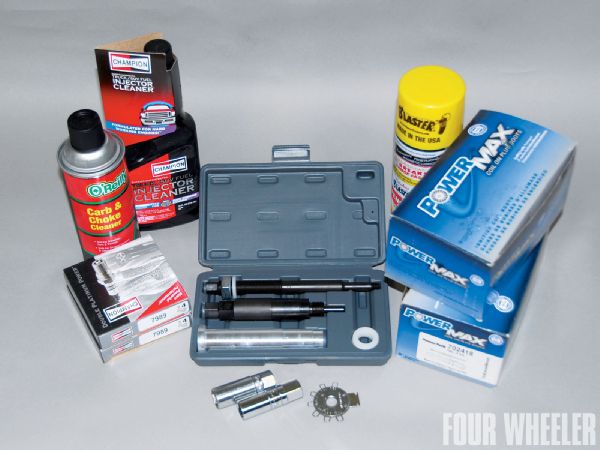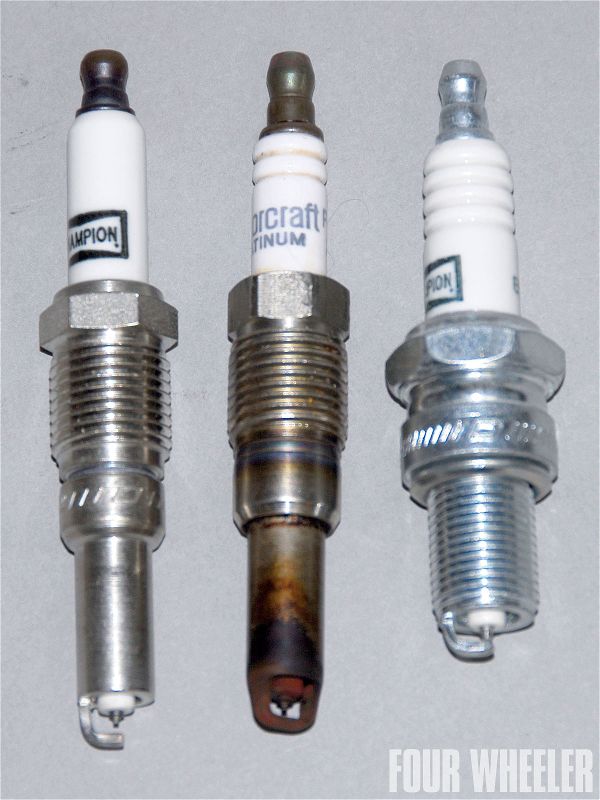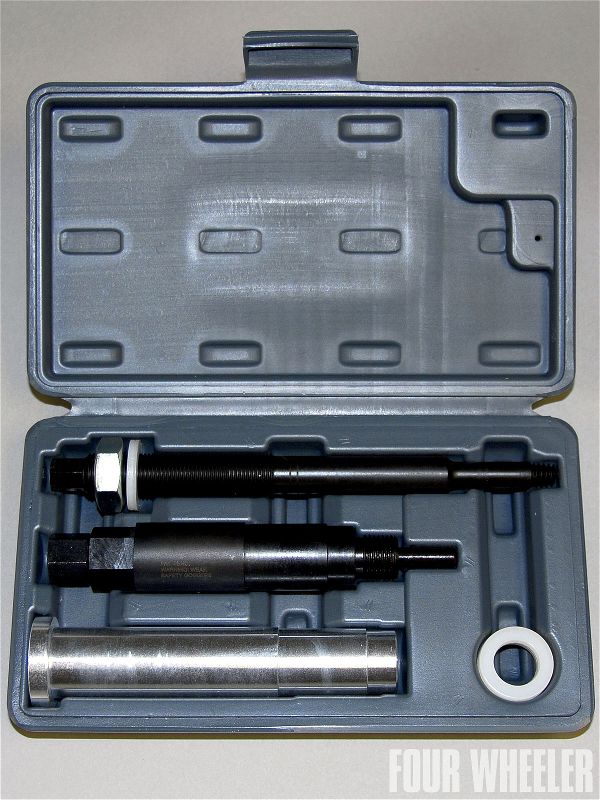
If you are the owner of a Ford truck with a three-valve (3V) modular V-8 or V-10 engine built from 2004 thru 2007, you have either faced the misery of broken spark plugs-or you will. The Ford 4.6L, 5.4L or 6.8L 3V engines are some of the best and most durable engines Ford has ever built, but like Superman, they have a Kryptonite weak link. In this case, it's the OE Motorcraft spark plugs. They don't typically fail in service but often break upon replacement, leaving a piece in the cylinder head that can lead to an expensive repair.
 The Boy Scout motto is "Be Prepared." Here is most of what you need to deal with broken spark plugs in your 3V Ford Modular. The cost of this would be around $250 in most places. Our informal survey of the costs of having it done at a dealer or independent repair shop range from $600 to $1,200, with only a few broken plugs. If parts fall into the cylinder and the head must be removed (which necessitates lifting the cab), the cost can run $2,000 to $3,000.
The Boy Scout motto is "Be Prepared." Here is most of what you need to deal with broken spark plugs in your 3V Ford Modular. The cost of this would be around $250 in most places. Our informal survey of the costs of having it done at a dealer or independent repair shop range from $600 to $1,200, with only a few broken plugs. If parts fall into the cylinder and the head must be removed (which necessitates lifting the cab), the cost can run $2,000 to $3,000.
The High-Thread (HT) Motorcraft plugs for the three-valves built through 2007 (built by Autolite and also sold under the Autolite name) are a multi-piece design. Carbon buildup inside the combustion chamber locks the lower part into place. It can take as little as 35 lb-ft to break that piece off the main body and it remains in the head. It's almost a guarantee that at least one spark plug will break. What happens after that depends on the knowledge, skill, and toolbox contents of the technician doing the job. With the right tools and knowledge, the problem is usually solvable without major pain or expense, bearing in mind that shops will charge actual time on this job. If the tech is clueless or careless, the vehicle owner can be in for a wild ride.
Early on, Ford developed a special removal tool and came out with a Technical Service Bulletin (TSB) with detailed service procedures. That original 2006 TSB has been updated several times, with the final one being TSB 08-7-6 (you can easily find it on the web). For 2008, Ford redesigned the 3V cylinder head to use a new one-piece spark plug. Unfortunately, it will not retrofit to the older heads and Motorcraft/Autolite hasn't altered the design of the 2004-07 plugs. Even though Ford specifies the use of a nickel antiseize on the tip upon replacement, there is plenty of evidence that those plugs will do the same thing in another 60,000 to 100,000 miles, at least a good portion of the time.
Because it's such an oddball spark plug, the aftermarket doesn't offer many other choices. Besides Motorcraft and Autolite, there are only Brisk and Champion. These latter two are both one-piece plugs that won't break. The Brisk plugs, however, are designed for competition; the heat ranges and construction materials may not be ideal for a stock engine in low-speed operations. Currently, that leaves Champion as your best bet. Champion was clued in right away to the problem, but it took a couple of years to come up with a design didn't get them into patent-infringement hot water.
Lisle Tools also entered the game early on with help. They looked at the Ford kit and came up with a better idea of their own, one that was much less likely to drop bits and pieces into the combustion chamber. The general consensus seems to be that, among techs that have tried both, most prefer the Lisle, saying it's easier to use and hundreds of dollars cheaper. Lisle has also managed to amass a pretty good bag of tricks in dealing with unexpected problems.
Change Now Or Later?
The owner's manual for 3V-powered trucks may list a 100,000-mile service interval for "normal" operating conditions and a 60,000-mile interval for "special" conditions. Ford defines "special" as lots of low-speed operation and city-type driving. Techs and industry professionals hint that seldom are OE sparkplugs of any type delivering optimal performance past 60,000 miles, so they recommend replacing the plugs in the 50,000- to 70,000-mile range for optimum fuel economy.
There is a not-always-apparent rhyme or reason to which 3V engines will have broken plug problems and which will not. Techs we asked have seen plugs break off at 11,000 miles and have had all eight come out at 100,000 miles. These are at the ends of a broad spectrum of experiences, and both are relatively uncommon occurrences. Generally, the earlier you do the change, the better the chances of fewer breaking off-but it's no guarantee. The consensus seems to be that most cost-effective solution is to get some miles out of the OE plugs, and then either get the Lisle tool and be ready, or find a shop that is well versed in removing the plugs. Individual owners who perform DIY changes seem to prefer getting them outta there ASAP once they learn of the problem. There's really no wrong answer if you are prepared to deal with it.
Strategy and Tactics for a Successful Change
This step-by-step will give you the hands-on highlights, but we want to offer some long-term strategies and emphasize short-term tactics that will increase the odds of (relatively!) trouble-free spark plug replacement. Step one on the strategic scale is using a high-detergent gasoline, which will help reduce the combustion chamber carbon deposits that grab the spark plugs. There are minimum federal standards for detergent additives in gasoline, but a group of six automakers think they are inadequate, having suffered from drivability and emissions problems for years. Some of the fuel industry responded, and there are major fuel suppliers that offer gasoline with a higher-than-mandated level of detergents. Appropriately, they are called Top Tier Gasolines, and you can see for yourself which suppliers are on that list by looking at the Top Tier website at www.toptiergas.com.
 Two versions of the 3V HT spark plug and a conventional long-reach plug. On the left is the one-piece Champion 7989 that was introduced in 2007. It features a platinum-tipped J-gap ground electrode and platinum center electrode. In the middle is the OE Motorcraft two-piece plug with a U-gap ground electrode of a conventional nickel material with a platinum center electrode. There are premium versions of Autolite HT that are double platinum, but they are still the multi-piece design. The Champion 7989 spark plug is the replacement for all the 3-valve engines. Though the U-gap plug looks kinda whiz-bang and may transfer heat a little better, Champion's tests showed the difference was not significant and that the J-style is less shrouded and delivers a little more spark where it needs to be. Starting with the 2008 models, the 3V head designs were modified to use a long -reach, J-gap plug similar to the one on the right-and maybe that says a lot.
Two versions of the 3V HT spark plug and a conventional long-reach plug. On the left is the one-piece Champion 7989 that was introduced in 2007. It features a platinum-tipped J-gap ground electrode and platinum center electrode. In the middle is the OE Motorcraft two-piece plug with a U-gap ground electrode of a conventional nickel material with a platinum center electrode. There are premium versions of Autolite HT that are double platinum, but they are still the multi-piece design. The Champion 7989 spark plug is the replacement for all the 3-valve engines. Though the U-gap plug looks kinda whiz-bang and may transfer heat a little better, Champion's tests showed the difference was not significant and that the J-style is less shrouded and delivers a little more spark where it needs to be. Starting with the 2008 models, the 3V head designs were modified to use a long -reach, J-gap plug similar to the one on the right-and maybe that says a lot.
The second step is to run a tank or two of fuel treated with an injector cleaner/deposit remover before doing the change. There are many on the market, including the one Champion sells under its own name. We have had good luck with the Chevron/Texico Techron product and the similar Techron-based Shell V-Power product.
As far as hands-on tactics go, as detailed here but worth repeating, give the penetrant time to work. If you can, let it soak overnight to really loosen up that carbon. The chemical will wick past the threads and down the tip. Also, to avoid misfires, plan on replacing the COP (Coil on Plug) boots. Finally, save yourself the aggravation of more broken plugs later and go to the most suitable one-piece plug, the Champion.
Doing the Deed
This being so prevalent a problem, we thought bringing you the cures from a very knowledgeable source was important. We also figured that if a ham-fisted journalist could do it, so might you. To aid us in that we enlisted the aid of Roger Bentdahl, a Technical Service Engineer from Federal-Mogul (the parent company of Champion), whose job was to help determine service procedures for this problem and who is now training techs and industry people about it. Having Roger there was kinda like getting Arnold Palmer as a golf coach.
Roger's tips and the Lisle tool instruction sheet differ from Ford's TSB. That's partly because the Lisle removal tool is very different from Ford's and partly from the many other methods that have been successfully tried. We leave it to you to get and read the Ford TSB, compare it to the Lisle method, and decide which way you prefer. Basically, all methods are proven to work.
When you are fully prepared for a problem, it often serves as a cosmic get-out-of-jail-free card. Such was the case with us. The aforementioned ham-fisted journalist followed Roger's directives, and all eight came out with the accompanying screech of joy. Roger's eyebrows gradually crawled to the back of his head as each succeeding plug came out in one piece. He stated that the odds against it were at least 30 to 1, and that there were techs out there who had done many plug changes on 3Vs and never had all eight come out. We must be living right!
The answer seemed clear. In looking at the plugs, we noted very little carbon. We had not had time to run any deposit removing additives in the fuel and had only soaked the plugs for 15 minutes. We can only surmise it was the steady diet of Top Tier Shell gasoline that made the job easy. Also, our engine burns no oil.
Final Words
The truck is running 100 percent on the Champion plugs, and we are happy the next plug change in 60,000 miles will be uneventful. Currently, Champion is offering replacement plugs in the standard heat range. Plans are afoot to launch a wider variety of heat ranges to cover the performance realm, including supercharged engines.
List of Affected Vehicles and Engines
(per Ford TSB 08-7-6, April 1, 2008)
Tools & Parts Needed for a Champion Upgrade
Dire Straits: Using the Lisle Tool When Things Go Bad Who is this masked man? The Lisle Tool should be wearing a white hat and a black mask. Like the old Lone Ranger, it rides in to the rescue and snatches your Ford 3V engine from the jaws of catastrophe. Many people think this tool is the best $99.95 (current list price) they ever spent.
 PhotosView Slideshow
PhotosView Slideshow














